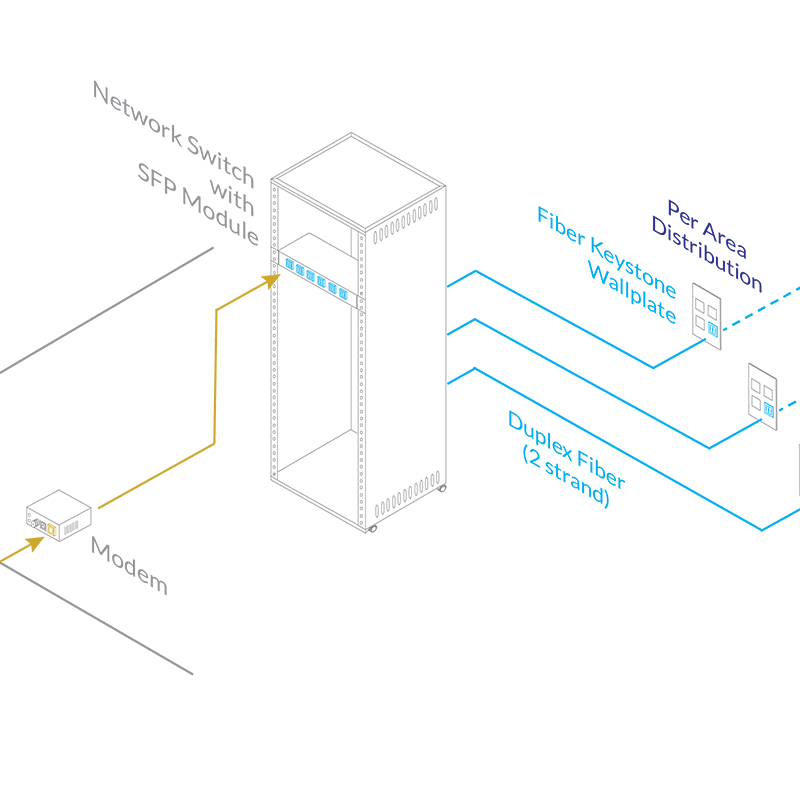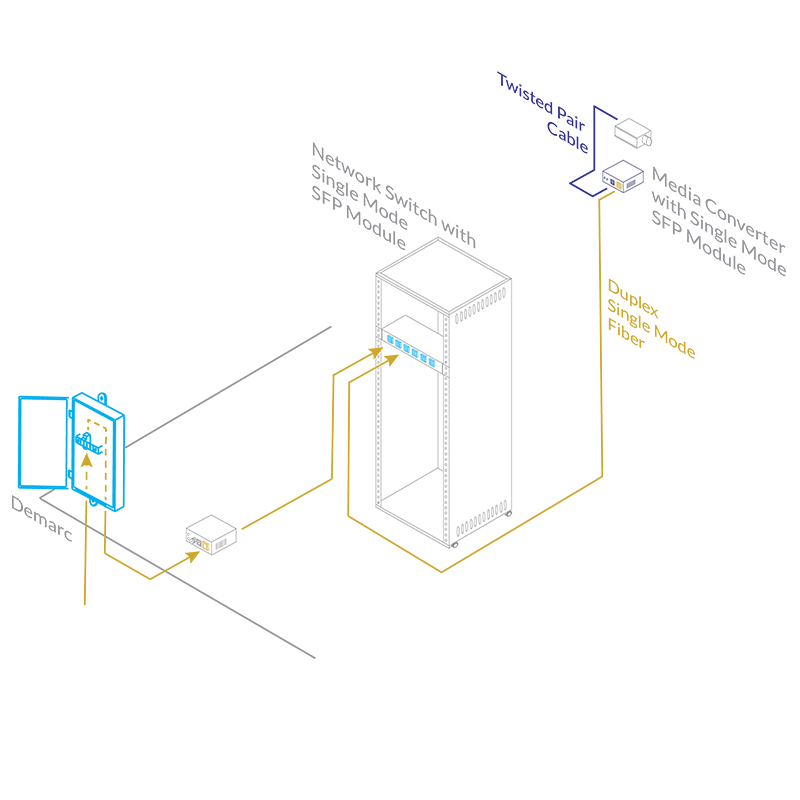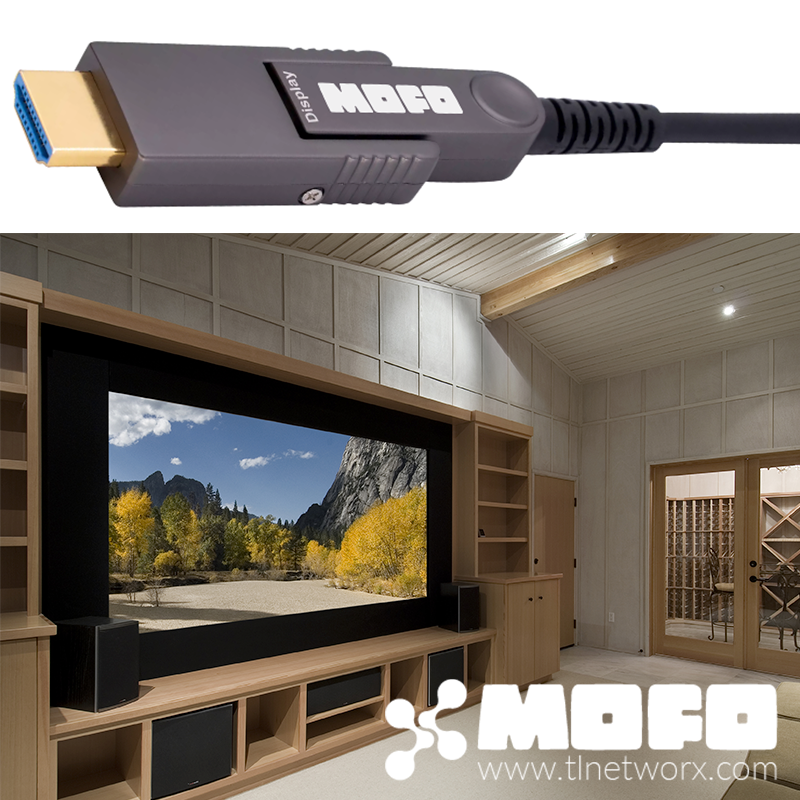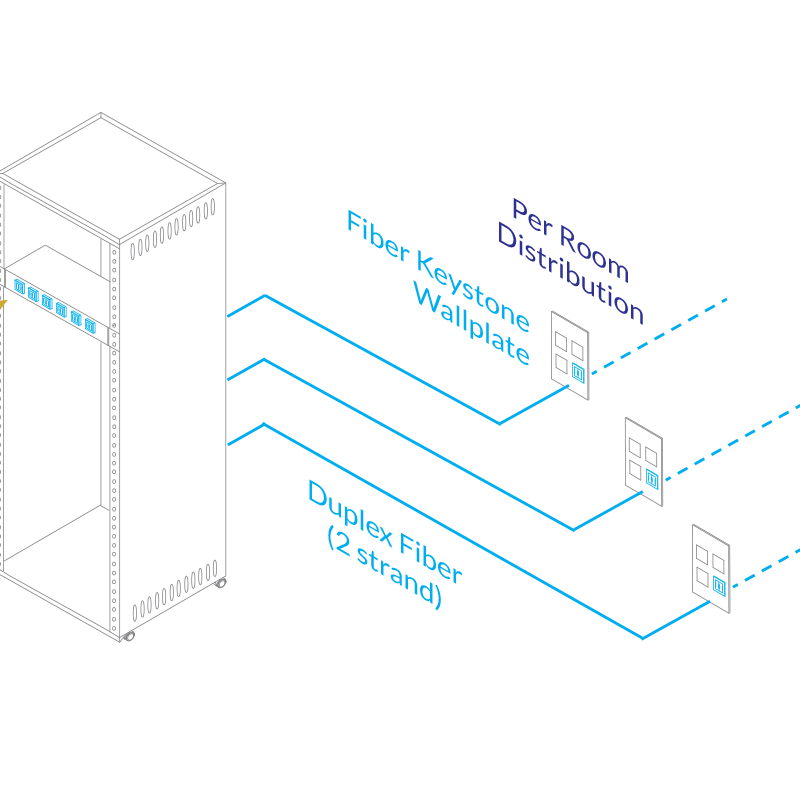Application Guide: Wiring Commercial Buildings with Fiber Optic Cable

Commercial buildings are increasingly wired with fiber optic cable to future-proof installations and create more reliable, higher-bandwidth and faster speed network and video infrastructures. In larger projects, fiber-based systems also easily exceed the distance limitation of twisted pair-based systems (100m / 330ft.) and provide signal immunity to static, surges, lightning and interference.
Application Drawings:

Fiber optic cable is used for everything from demarcation point wiring to network signal distribution to video signal extension. Often, fiber enters the structure to a centralized rack or data room where it is connected to a modem. The modem connects to a network switch which connects each remote point (rooms, floors, distributed network switches, etc.) throughout the facility.

Larger projects often feature a main distribution frame (MDF) that interconnects and manages the telecommunications wiring between itself and remotely located intermediate distribution frames (IDFs). The MDF typically connects external public lines coming into the building with the internal private lines that feed back from the IDFs.
In practice, the MDF is typically centrally located near the demarcation point, whereas the IDFs are located on each floor, wing or unit within the building.
Fiber optic cabling and fiber-ready enclosures, including rack trays and wall-boxes, are often used for MDF and IDF wiring because they support long cable distances and very fast network speeds. Fiber-based systems easily exceed the distance limitation of twisted pair-based systems (100m / 330ft.), and they easily support network speeds exceeding 10Gbps. It’s also common to see multi-strand fiber optic cabling, such as 6 strand and 12 strand, connecting the MDF to the IDFs to accommodate signal distribution to individual rooms and/or devices.

Fiber optic cable is increasingly used to extend video signals such as HDMI, DVI and DisplayPort. Fiber supports the bandwidth required for native 4K HDR (up to 18G) and 8K (up to 48G), and it future-proofs for planned standards such as 12K and 16K.
Video over fiber extenders typically leverage the same standard fiber optic cable and connectors commonly used in data applications, such as duplex multimode OM3 with LC connectors and single mode OS2 with LC connectors.

One of the most common applications for fiber optic cabling in any structure is demarcation wiring, including connecting the fiber service feed to the building’s network distribution point. Integrators are commonly faced with:
- Existing installations where the service feed must be moved or extended
- New construction where the service feed isn’t yet installed and a demarcation point must be prepared by the integrator
Notes When Wiring a Demarcation Point:
SC-style connectors are commonly used in demarcation wiring and are available in two formats: APC (angled polish) and UPC (ultra or flat polish). APC connectors are typically green and UPC connectors are typically blue. Always terminate single mode connectors onto single mode fiber and try to match the connector type to the service provider’s connector type. When in doubt, terminate APC (green) connectors.
Commonly Used Prewire Fiber:
TechLogix S2I-2M-P-BK single mode ECOfiber™ is commonly used to prewire structures. It future-proofs installations for less cost than shielded twisted pair and terminates using standard tools and connectors. It’s small, strong, plenum-rated, outdoor-rated, black jacketed and universally compatible with single mode devices thanks to Corning SMF-28 Ultra® OS2 fiber.

What makes TechLogix S2I-2M-P-BK different? It's built specifically for building prewires and is universally compatible with most applications.
- Ideal for building prewires, demarcation wiring and general signal distribution
- Two strands of industry-leading Corning SMF-28 Ultra® optical fiber
- Versatile plenum and indoor/outdoor-rated jacket
- Black color for low-profile installations
- Ultra-small 4.4mm / 0.17” jacket
- Ultra-pliable 7.5mm / 0.29” bend radius
- Ultra-strong 100lb. pull-rating
- Compatible with standard fiber tools and connectors
- Available in bulk and pre-terminated
Plus it's smaller and more durable than most comparable fiber optic cables.

Fiber has always outperformed twisted pair in bandwidth, and thanks to TechLogix ECOFiber it also now excels on ease of installation and price.

Commonly Integrated Products:
 |
Metal Wall-Boxes Metal wall-boxes provide a secure connection point to connect fiber optic cables and manage service loops. Metal wall-boxes require an insert panel for connecting cables. View |
 |
Rack Trays Rack trays provide a secure connection point to connect fiber optic cables and manage service loops. They fit standard 19” and 23” racks. Rack trays require an insert panel for connecting cables. View |
 |
Insert Panels Insert panels mount inside metal wall-boxes and rack trays. They |

|
Indoor/Outdoor Wall-Boxes Indoor/outdoor wall-boxes are ideal for both indoor and outdoor applications. They provide a secure connection point to connect fiber optic cables and manage service loops. View |

|
Couplers Couplers mount inside indoor/outdoor wall-boxes and physically connect two cables. View |
 |
Keystone Wallplates Fiber optic keystone wallplate inserts provide a secure and aesthetic cable termination point and/or connection point between the main cable run and a shorter patch cord. View |

|
Video over Fiber Extenders Extenders transmit audio, video and control signals over fiber optic cabling. View |

|
Pre-Terminated Fiber Cable Premade fiber optic cables arrive pre-terminated with connectors and are available in stock and custom configurations. View |

|
Bulk Fiber Cable Bulk fiber cable requires termination in the field and is available in stock and custom configurations, including with direct burial armor. View |

|
Fiber Optic Connectors Fiber optic connectors terminate on bulk fiber cable. View |




Comments